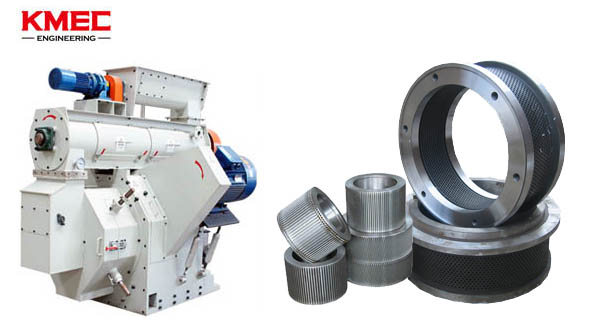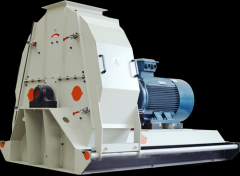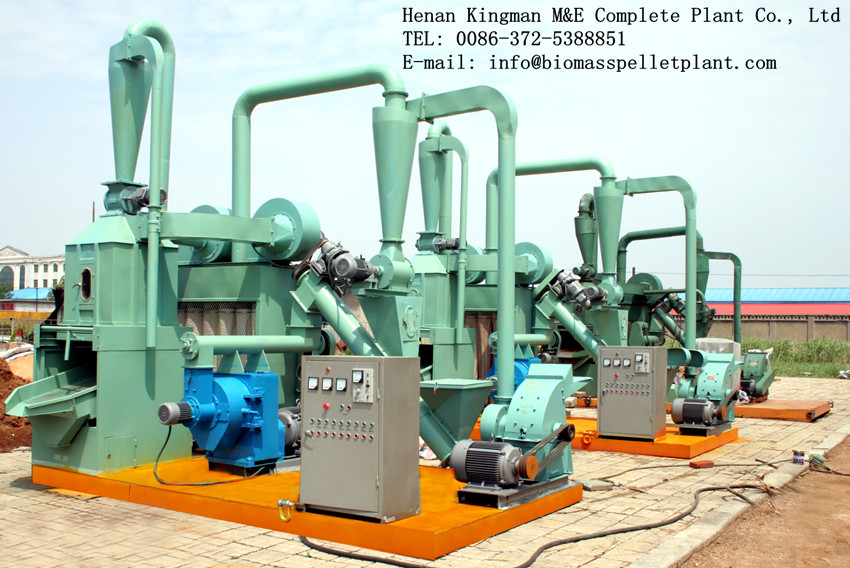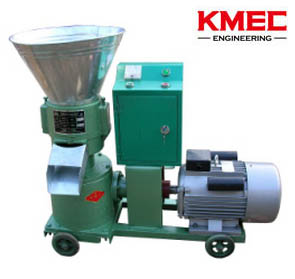The reasons for wear of ring die of the pellet mill
Ring die is relatively easy to wear in the structure of the pellet mill. When the particle forming rate is reduced to 75%, we can think that the ring die has failed. So it is very important to study the cause of the failure for the ring die. It has great effect on improving the output and quality of the pellets. At the same time, it can also contribute to reduce energy consumption and production costs. After a lot of observation and analysis in the practice of production, the failure modes of the ring die can be divided into the following several aspects:
From the actual failure phenomenon of the ring die, it can be divided into three kinds. First kind: after working for a period of time, inner wall of the discharge holes wears, thus the diameter of the holes increases. The diameter of pellet feed produced exceeds the specified value that causes the failure; the second kind: after the wear of inner ring die, the inner surface becomes uneven seriously, which makes the feed flow blocked. The discharge quantity decreased while stopping; third: when the inner ring die wears, the diameter of it increases so that the wall thickness decreases and the inner wall of discharge hole wears as well. It makes the wall thickness between the discharge holes thinning continuously, thus decreases the structural strength. Before the diameter of discharge holes increases to the allowed specified value (i.e. before the failure of the first class), crack will first appear in the most dangerous section and continue to expand, until the crack extends to a larger range that causes the invalidation of the ring die. In sum, the substantive reason that causes the three kinds of failure phenomenon above, the first is abrasive wear, then the fatigue damage.
2.1 Abrasive wear
There are many reasons for the wear, it can be divided into the normal wear and abnormal wear. The main reasons for normal wear are the formula of the material, the size of the crushing, conditioning quality of the powder, etc. Under normal wear condition, the ring die appears axial uniform wear, resulting enlargement of die hole and thinning of the wall. The main reasons of normal wear: the press roller is adjusted too tight and the gap between the ring die and press roller is small that causes the mutual wear; the angle of the feeder is not good, resulting in uniform material distribution and some parts wear first; metal fells into the die that causes wear. In this case, the ring die appears irregular wear, most of which are drum types.
2.1.1 Particle size
Raw material crushing fineness should be moderate, because the raw material crushing fineness determines the surface area of feed composition. The finer the particle size is, the larger the surface area will be, and more quickly the material absorbs the moisture. It is conducive to the conditioning and form of the pellets. If the particle size is too coarse, it will increase the wear of the pressing die and cause productivity decline and increase of energy consumption. After crushing all of the raw material is generally required to pass through the 8 mesh sieve, and 25 mesh sieve can not left more than 35%. For material of high content of crude fiber, adding a certain amount of oil in the granulation process can reduce the friction between the material and the ring die and helps material through the ring die, also makes the appearance smooth after forming.
2.1.2 Impurity situation of the material
If the material contains too much sand and iron impurities, it will accelerate the wear of the pressing die, so the raw material cleaning work is very important. At present, the majority of manufacturers pay more attention to remove the iron impurities in the raw material, for the iron material will cause a strong destruction on the pressing die, press roller and even the equipment. While think little of the removal of sand and gravel impurities. This should arouse the attention of the pellet mill users.
2.1.3 Addition of steam
Add steam to the material can soften the material and split cell tissues that contain oil of the material to make the oil free. It works as lubrication in the granulation process so as to reduce the die wear caused by the material and improve production of the pellet mill. Generally steam pressure added should between 0.2 ~ 0.4MPa. The pressure varies with the variety of suppressed materials. For materials with high protein content, the steam pressure should be slightly lower. For materials containing more fiber, steam pressure can be slightly higher. The moisture content of the material should be 16% to 17% after adding steam, and the best temperature of the material after conditioning is 78 ~ 87~C.
2.1.4 The gap between the ring die and roller
If the gap between the ring die and the roller is too small, it will speed up the surface wear of the ring die and roller, especially in the free run period when pellet mill starts and stops, the wear effect is more intense. Taking into account of the roundness error of the surface of the ring die and the roller and the coaxial error between the working surface and the mounting surface, the gap between the ring die and the roller is generally 0.2 ~ 0.4mm. When suppressing pellet feed with small diameter or using new ring die chooses the smaller value.
2.1.5 Feeder installation angle
If the feeder installation angle is not correct, it will cause the material distribution between the ring die and roller uneven. Therefore, the extrusion stress and the friction force of the ring die and roller are not uniform along the axial direction, which leads to uneven distribution wear of the ring die and the roller.
2.2 Fatigue failure
The ring die of the pellet mill is a porous ring part. If the working condition is bad, after a long time of bearing the pressure of press roller and friction of the material in the course of using, it will produce bending stress and contact compression stress. But these stress is not the factor that affects the service life of the ring die. The main failure mode is the fatigue failure. In "study on ring die strength of pellet feed press", Huang Chuanhai analyzed the force condition of the ring die in working process, he thought that ring die is exposed to alternative stress during its operation and the cyclic characteristic of alternative stress is:
This shows that the alternative stress is asymmetric cycled, and the ring die usually occur fatigue failure. It is consistent with the failure result generated in the actual use of the ring die. On the basis of the above, it is suggested that the bending resistance and the productivity of the ring die can be improved by increasing the ring width, thickness and inner diameter. To effectively improve the stress condition of the ring die, in addition to change the size of ring die, we can also choose the appropriate material and heat treatment technology, as well as the design of the surface percentage of opening of the ring die and so on. Ring die is usually made of carbon (alloy) steel or stainless steel through forging, cutting, drilling, heat treatment and other steps. In order to ensure the quality of each hole, porous gun drill should be used to drill holes. In heat treatment, the vacuum quenching device should be used to avoid decarburization of surface oxidation that occurs frequently in the common equipment, so as to obtain higher hardness.
The surface percentage of opening of the ring die directly affects the output of the pellet mill and the strength of the ring die. When the percentage of opening is large, the output of pellet mill is high and the strength of ring die is lower; on the other hand, the strength of the ring die improves, and the production of the pellet mill reduce. Because of the difference of material and size of ring die, to get proper value of the percentage of opening in order to make a better coordination of its output and service life, that is still a big difficulty. For ring die with a diameter of 2~12mm , the percentage of opening should generally between 20% and 30%. The smaller the die hole is, the smaller the percentage of opening is and vice versa. Manufacturers should take successive imminent test method according to the selected ring die material, shape and size to determine the percentage of opening and ensure sufficient strength of the ring die, and prevent the break of the load that shorten its service life. In the design of shape and structure of ring die, we should minimize groove amount along the outer surface in radial distribution of the ring die, and reduce its depth. Because the radial distribution groove is the part that most prone to stress concentration. Under the action of alternating stress for a long time, it is easy to produce microcracks in the site firstly, and then expand gradually, eventually causing the fracture of ring die.
The above analysis shows that there are two main failure causes in the process of production. One is the abrasive wear, the other is the fatigue damage. To fundamentally avoid the failure of the ring die is impractical. Only to improve the manufacturing, production and service conditions of the ring die, thereby prolonging the service life of the ring die and saving the cost.
----------------------------------------------------------------------------------------------------------------------------------------
----------------------------------------------------------------------------------------------------------------------------------------
Ring die is the central parts of sawdust pellet mill, and it is the quickest wearing part. According to estimation, the consumption ring die account for about 25% of the fee for repair in the whole workhouse. At the same time, it has direct relationship with the pellet quality.
News
- Small Pellet Machine Manufacturer-Kingman
- Application of Wood Pellets and Use of Biomass Pellets
- From Fossil Fuel into Biomass Pellet Fuel
- Biomass Pellet Making Machines Market
- Applying of pellet stoves for home use
- Highland pellets to build $130 million facility in arkansas
- How to deal with the blocked hammer mill
- How to Make Wood Pellets with Sawdust
- The government policy promotes the development of biomass fuel
- Market analysis of biomass pellet fuel
- Strategic positioning of renewable energy
- Biomass energy has pass through the pre assessment
- The key point of deep processing of biomass pellet
- Harbin is promoting the development of biomass machinery
- The development of biomass formation technology I
- The development of biomass formation technology II
- Biomass energy industry is now going full tilt in 2015
- Rapid increasing demand of sawdust pellet on the market
- Pellet fuel market in EU
- Chinese Biomass Energy Conference held in Beijing
- Future market development of straw pellet mill
- Peanut Shell Pellet Mill Makes High Quality Pellets
- The utilization of straw is only 5%, biomass energy needs our attention!
- Corn straw pellet machine relieves the tight supply of fuel energy
- Reasons for loose or not forming of biomass pellet mill






